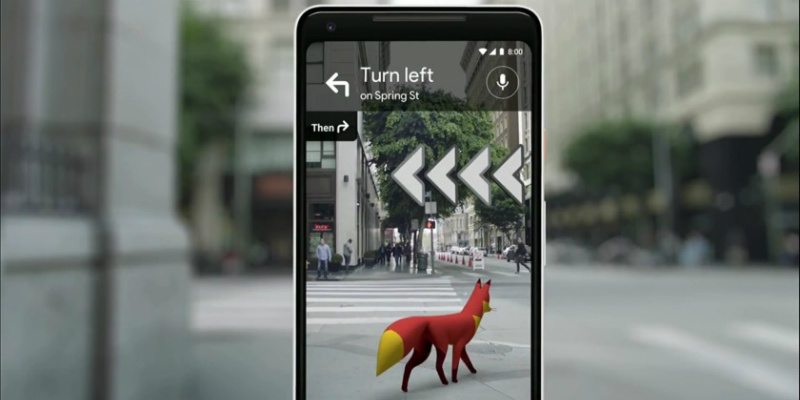A smarter Google Assistant. Android P beta features. Better Wear OS watches coming. Chrome OS Linux apps and augmented reality (AR). New Google Lens features. VR Tour Creator. Shared AR experiences. Camera assisted navigation. A new Google Maps app that aims to be your one-stop planner. Plus Google News, Android Auto and Android TV improvements. Whew—are you out of breath yet?
All of those and more were revealed at this week’s Google’s I/O developer conference by Google’s headquarters in Mountain View. Whether you’re a Googlehead, Android fan, or just a tech nut like us, read on below for your one-stop scoop:
Google Assistant gets a lot smarter, adds new voices
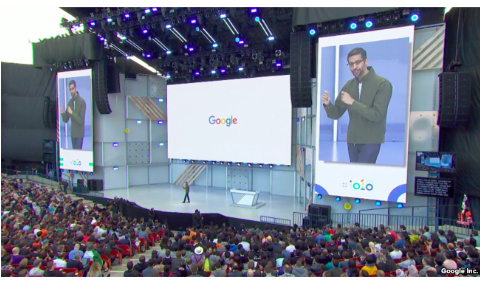 Even Google engineers must have grown tired of always yelling “Hey, Google” before every question. Now, you’ll only have to say “Hey Google” (or “Hi Google”) once to start off a “continued conversation” in which you can ask multiple questions, even with long pauses. And your conversation can now include more than one request in a question—for example: “Hey Google, what’s the weather like in London and Berlin?”
Even Google engineers must have grown tired of always yelling “Hey, Google” before every question. Now, you’ll only have to say “Hey Google” (or “Hi Google”) once to start off a “continued conversation” in which you can ask multiple questions, even with long pauses. And your conversation can now include more than one request in a question—for example: “Hey Google, what’s the weather like in London and Berlin?”
What really wowed the crowd at Google I/O was Google’s new Duplex AI (artificial intelligence) tech, shown off in a demo of Google Assistant calling a restaurant to reserve a table and a hair salon for an appointment. Because Google Assistant now can say human things like “um” and “uh huh”, she sounded human enough to fool the person taking the call.
So in the future when you want to make reservations or order a pizza, Google Assistant could feasibly do it for you. Google later clarified that it plans to add a disclosure or notice to whomever your Assistant calls, so that they know in advance that they’re speaking to a non-human. You can hear the amazing demos here.
If that wasn’t progress enough, now you can choose from six more voices for your Assistant, including the melodious tones of singer-songwriter John Legend. Finally, Google Assistant now can order food for you, and let you create customized routines for frequent requests.
On your phone, the Assistant will now give you a quick snapshot of your day, with suggestions based on the time of day, location and recent requests. Google is integrating popular notes and lists apps including Google Keep, Any.do, Todoist and others. If your device hasn’t already installed the new Google Assistant update, you can download it from the Play store.
And finally if you have a Google Home smart speaker, you can now finally tell it to play Google Play movies. Oddly until now, Google Home only let you do that for Netflix.
Android P features: the beta is here now
Google’s Android P beta is here now, and is packed with new features. The most important Android P features include support for smartphones with notches, a new home button / navigation slider, new swipe directions, fast access to your most-used apps, an easy way to separate “work apps”, smart brightness, and battery life savings.
One of the most exciting new Android P features is “App Actions”, which predicts what apps or media you’ll use before you launch them. For example: if you plug in headphones, Android P might load a playlist from your favorite music app, or if you type “Lyft”‘ in Google search, Android P might show how much a ride home would cost, without opening the Lyft app. App Actions is coming in June.
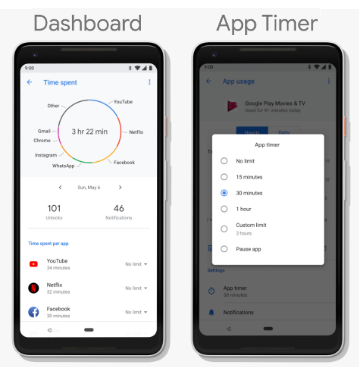 To help you reduce smartphone addiction, Android P also has a “digital well-being” dashboard that details your phone usage habits, such as how many times you’ve unlocked your phone, how many notifications you got, and how much apps time you spend. For example, you can see your total YouTube, and set time limits on it or other apps for yourself and your kids.
To help you reduce smartphone addiction, Android P also has a “digital well-being” dashboard that details your phone usage habits, such as how many times you’ve unlocked your phone, how many notifications you got, and how much apps time you spend. For example, you can see your total YouTube, and set time limits on it or other apps for yourself and your kids.
Android P also offers easier ways to manage notifications. If you put your phone in “Shush” mode by laying it down display facing down, you won’t get notifications except from your family, work or other designated contacts. At bedtime, Android P’s Do Not Disturb mode turns your screen black-and-white, and mutes all audible as well as visual notifications.
Better Wear OS watches coming this fall
Although Google didn’t show off new Wear OS watches at I/O, Qualcomm was there to say that it will announce its next-gen smartwatch processor this fall, along with new Wear OS watches from several brands. The next Wear OS watches will borrow many Android P features, such as longer battery life and AI that’s proactive about helping you with information you need or might want. The next Wear OS watches will also be smaller, more stylish, come with Bluetooth and Wi-Fi as standard, while some will also have LTE, said Qualcomm.
Chrome OS Linux apps & AR preview
Chromebooks are about to get a lot more capable, and probably more popular. Confirming many rumors, Google announced that Chromebooks will soon be able to run Linux apps in addition to the Chrome apps and Android apps already supported. Of course, Google’s high-end Pixelbook will be the first to support Chrome OS Linux apps before other Chromebooks do, but it didn’t provide a timeline.
![]() Chromebooks with Linux support means that Linux lovers will no longer need to install that OS in an unsecured folder, in developer mode. To run Chrome OS Linux apps, Google has built a custom, secure virtual machine that runs a version of Debian that’s directly integrated into the Chrome OS desktop. Google says that you’ll be able to open Chrome OS Linux apps right in the Launcher, and access Linux files in your Downloads folder.
Chromebooks with Linux support means that Linux lovers will no longer need to install that OS in an unsecured folder, in developer mode. To run Chrome OS Linux apps, Google has built a custom, secure virtual machine that runs a version of Debian that’s directly integrated into the Chrome OS desktop. Google says that you’ll be able to open Chrome OS Linux apps right in the Launcher, and access Linux files in your Downloads folder.
Besides being great for Chromebook users, the new Chrome OS Linux apps integration also benefits Android developers. As Engadget points out, they can now install Android Studio or other tools on a Chromebook, write code and test apps in ways that weren’t possible before.
Google is also bringing augmented reality (AR) to Chrome, though it didn’t say how soon, if even this year. At I/O, Google demoed some basic AR applications on Chrome, like viewing a statue in 3D.
New Google Lens features, coming to your camera
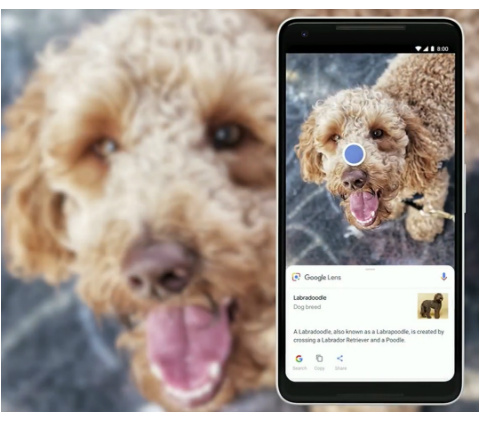 Google’s camera-based image recognition app Google Lens is getting new features: smart text selection, style match and real-time results. The Lens features could be useful for when you’re out shopping, reading a complicated or foreign menu, or just want to quickly find out more about something that catches your eye.
Google’s camera-based image recognition app Google Lens is getting new features: smart text selection, style match and real-time results. The Lens features could be useful for when you’re out shopping, reading a complicated or foreign menu, or just want to quickly find out more about something that catches your eye.
Smart text selection lets you copy and paste text from real-life things directly into your phone, and even quickly find the meaning of words from a document. In an onstage demo, Google showed how you’ll be able to tap around words on a menu, and Lens will tell you what that food is, complete with a visual guide and an ingredient list. For menus or other things in other languages, Lens works with Google Translate.
Just like Pinterest’s Lens feature, style match lets you camera-scan a real life object, and the app will help you find and even buy identical or similar items online. Style match, smart text and other Google Lens features now all happen in real time, so as soon as you point your phone camera at something, Lens will process it in just a second. For example, move your camera lens over a concert poster and it’ll start playing a related music video from the artist.
Engadget tried out the new Google Lens features and found them mostly smooth, but sometimes clunky. Google says you’ll see the new features added “in the next few weeks”.
New Google Maps app aims to be your one-stop planner
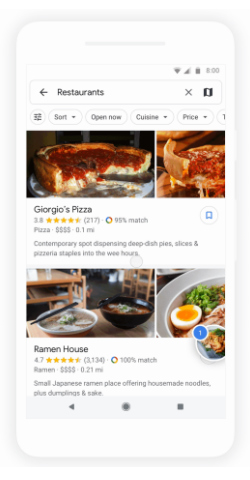 Starting this summer, Google Maps will get a lot more personal. The new Google Maps app will show you nearby restaurants, stores, services and events that are either popular or based on what Google knows of your recent searches, likes and reviews. To save you from visiting services like Yelp or Travelocity, the new Google Maps app will show you content from “trusted providers”.
Starting this summer, Google Maps will get a lot more personal. The new Google Maps app will show you nearby restaurants, stores, services and events that are either popular or based on what Google knows of your recent searches, likes and reviews. To save you from visiting services like Yelp or Travelocity, the new Google Maps app will show you content from “trusted providers”.
The first thing you’ll see in the upcoming new Google Maps app is the improved Explore tab, which lists the popular things people look for in your area, and if you’ve been there or not. Each week you’ll also see a new “Trending” list of hotspots. If you don’t like those, you can go to the “For You” tab, which shows you places and events based on what Google knows about your interests.
Finally, Google Maps’s new Group Planning feature lets you save places to a list and share that list with friends, who can vote on your choices. Engadget tested the new Google Maps app, and is pretty excited about it.
Camera assisted navigation preview
At a busy intersection and confused about which way to go? Google’s new “Virtual Positioning System” camera assisted navigation aims to help. For example if you don’t know where you’re going, you can enter a destination in your phone, launch your camera, hold up your phone, and the lens will compare where you’re standing to Google’s Street View database. Once your position is known, an arrow will appear on the screen, telling you if you need to go left or right. You’ll also get to choose if you’d like to follow an augmented reality avatar to guide you, such as a friendly red fox (see image top of this page).
Google didn’t say when its VPS camera assisted navigation is coming, but it’s likely to be added later this year. Other companies already have camera assisted navigation apps; last fall Blippar launched an AR City app for iPhones.
Shared AR experiences, now in ARCore
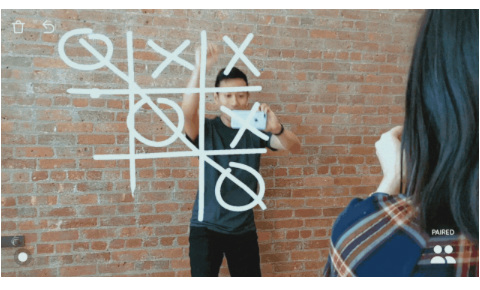 If you and a friend both have Google’s ARCore installed on your phones or tablets, you can now share the same augmented reality experiences, thanks to a new technology called Cloud Anchors. That means you’ll be able to tag real-life objects and then share those tags with friends. For example, you can all play a virtual game in the real world, or decorate a room together by moving around virtual furniture or artwork. You can even place AR objects on textured walls, thanks to ARCore’s new “Vertical Plane Detection” technology. And you don’t all have to be Android users—these shared AR experiences will also be available to iOS users.
If you and a friend both have Google’s ARCore installed on your phones or tablets, you can now share the same augmented reality experiences, thanks to a new technology called Cloud Anchors. That means you’ll be able to tag real-life objects and then share those tags with friends. For example, you can all play a virtual game in the real world, or decorate a room together by moving around virtual furniture or artwork. You can even place AR objects on textured walls, thanks to ARCore’s new “Vertical Plane Detection” technology. And you don’t all have to be Android users—these shared AR experiences will also be available to iOS users.
Another new feature is Augmented Images, which will let you “bring images to life”, says Google. For example, you can see what’s inside a box just by pointing your camera at it, assuming that there’s already an AR app connected to that box. Google is rolling out the new ARCore update now.
If you’re a Java developer wanting to build Android AR apps, it’ll now be faster and easier thanks to ARCore Sceneform integration, which lets you build 3D apps without complicated APIs like OpenGL. You can use it to build AR apps from scratch, or add AR features to your existing apps. Google says ARCore Sceneform is highly optimized for mobile.
Google News app gets smarter with AI
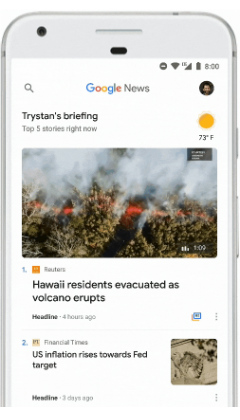 Google has totally redesigned its Google News app, which will leverage more AI and machine learning tech in real time to analyze and organize news stories. The Google News app now shows you personalized content that includes your top five curated headlines, and then a list of news topics that Google knows interest you.
Google has totally redesigned its Google News app, which will leverage more AI and machine learning tech in real time to analyze and organize news stories. The Google News app now shows you personalized content that includes your top five curated headlines, and then a list of news topics that Google knows interest you.
The new Google News app also learns and automatically updates your preferences as you use it, but you can manually dictate whether you want to be shown more or less of specific subjects or news media.
If you want to read more about any topic that interests you, there’s a “Full Coverage” section, and you can quickly subscribe to and read stories from popular, reputable newspaper services, just as in Google’s Newsstand app. The updated News app is now available via Google Play in the US, and will be available in 127 countries by the end of next week.
VR Tour Creator targets schools, travel, real estate
Want to share your favorite places or create educational videos in 3D? Now you can create your own virtual reality tours with Google’s new VR Tour Creator tool, which lets you take and use your own 360-degree photos and Google Street View images. After you’ve created your tour, you can publish it to Poly, Google’s online 3D images library, where you can view it in your browser or in a Google Cardboard viewer. You can also post your tour to other websites, and later this year, you’ll be able to add it to Google’s Expeditions app. You can see demos and get started here.
Android Auto update brings voice texts, easier media play
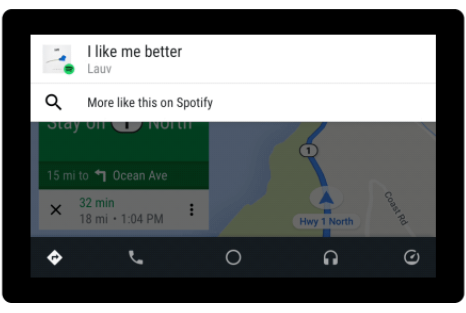 If you’re stuck in traffic and running late, you’ll soon be able to use your Android Auto system to group text your friends or work team with your voice. That’s thanks to Auto’s new support for the SMS-replacement standard Rich Communication Services (RCS) and support for Google Assistant. The upcoming Android Auto update also will make it easier for you to quickly find and play media with your voice or a tap. You’ll be able to see songs and podcasts at a glance, and if you like a song you can tap or ask for related music, such as live or cover versions.
If you’re stuck in traffic and running late, you’ll soon be able to use your Android Auto system to group text your friends or work team with your voice. That’s thanks to Auto’s new support for the SMS-replacement standard Rich Communication Services (RCS) and support for Google Assistant. The upcoming Android Auto update also will make it easier for you to quickly find and play media with your voice or a tap. You’ll be able to see songs and podcasts at a glance, and if you like a song you can tap or ask for related music, such as live or cover versions.
But Google and Apple had better do more with auto infotainment than minor updates, because they are now facing more competition from automakers, who have finally realized that they need to differentiate themselves in that area to better compete. So, the future of Android Auto and Apple CarPlay may be more automaker partnerships and customization. Google has already partnered with automakers like Audi and Volvo to integrate voice search and maps into vehicles, and Apple is doing the same.
Android TV updates + 4K Android TV dongle for devs
At I/O, Google demoed Android TV using Android Oreo and Google Assistant, which are part of what it calls a “content first” app experience. New in the latest version of Android TV is easier setup, autofilling of passwords for your media accounts, a smarter settings menu that tries to learn what you want to watch, more AI-based assistant features, more languages, support for more countries, and an easier user experience for iOS or laptop users. The Android TV platform is now supported by over 100 partners and offers over 3,600 apps and games.
And if you’re an Android developer, you can sign up to get the ADT-2, which is Google’s 4K Android TV dongle to help you create Android TV apps.
